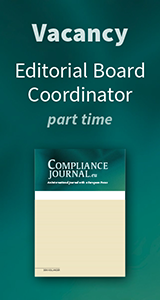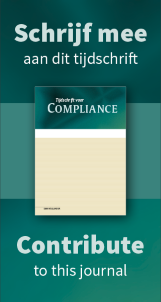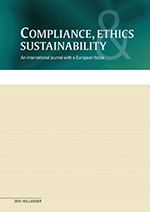Breaking the silence from the inside: how to mitigate the increasing external whistleblowing risks?
S. Oded and I.M. Braam
1. Introduction Shortly after John Slowik became the first Chief Compliance Officer of Olympus Corporation of the Americas, he revealed a kickbacks scheme through which Olympus had paid hospitals and physicians for buying Olympus's endoscopes. John immediately reported the scheme to Olympus's management. However, the management chose to ignore John's report. Eventually, John blew the whistle to the U.S. authorities and the rest is history: in March 2016 Olympus agreed to pay USD 623 million to
Artikel kopen € 79,00 excl. BTW
In plaats van abonneren kunt u dit artikel ook afzonderlijk kopen.
resolve civil and criminal charges related to the scheme. As part of this settlement, John himself was awarded USD 51 million in relation to his whistleblowing.1 The Olympus case is one of the milestones in an emerging global trend of increased corporate liability exposure due to employee reporting of corporate misconduct to regulatory or enforcement authorities, i.e., external whistleblowing. Various policymakers around the globe have recognised the advantage that corporate employees may have over regulatory authorities with respect to their access to information about corporate misconduct. These employees are often the ‘eyes and ears’of the company who witness first red flags indicating corporate misconduct. This recognition has led to the recent proliferation of policy reforms aiming to encourage employees to share information about corporate misconduct with the relevant authorities. Many of these legislative reforms also encourage, and under certain circumstances oblige, corporations to establish reporting mechanisms that allow employees to blow the whistle internally. One key element in most recent reforms is the strengthening of whistleblower protection against retaliation. While until the early 2000s merely four OECD countries had whistleblower protection laws in place, in the last decade this number has more than tripled, with nine additional OECD countries, including the Netherlands, passing new whistleblower protection laws.2 Whistleblowing is likely to remain a focal point in upcoming policymaking Whistleblowing is likely to remain a focal point in upcoming policymaking. Further legislative reforms and policy developments in relation to whistleblowing are expected to be enacted following the recent adoption of the EU Market Abuse Regulation (no. 596/2014), which becomes effective on 3 July 2016. This new Regulation requires Member States to 'ensure that adequate arrangements are in place to enable whistleblowers to alert competent authorities to possible infringements of this Regulation and to protect them from retaliation.'3 From a corporate perspective, the strengthened motivation of employees to share potentially incriminating information with enforcement authorities may have a dramatic impact on corporations' legal and reputational exposure. Obviously, the sharing of such information may lead to criminal, administrative and civil actions against the corporation, which in turn may result in substantial fines and possibly severe reputation damages. Therefore, a key question addressed by this article is: How can corporations effectively mitigate the increasing risk of employees blowing the whistle externally? In this article, we suggest that a practical way for corporations to deal with the increasing risk of external whistleblowing is to establish a meaningful internal alternative. Internal reporting mechanisms have increasingly been recommended by enforcement authorities as one of the hallmarks of effective corporate compliance programmes.4 As we show below, such internal mechanisms have also become mandatory for certain corporations. This article suggests that beyond the need to satisfy any such mandatory regulatory requirement, maintaining an effective internal reporting system may assist corporations in mitigating the increasing liability risk resulting from external whistleblowing. This article is structured as follows: after briefly introducing a selection of noteworthy policy reforms in relation to whistleblowing in the Netherlands, U.S. and U.K., this article explores the important role internal reporting mechanisms may play in reducing corporate liability exposure. We then proceed by sketching a three-step internal reporting mechanism which can be considered by corporations in order to break the silence from the inside, thereby mitigating the growing liability risks.
U heeft op dit moment geen toegang tot de volledige inhoud van dit product. U kunt alleen de inleiding en hoofdstukindeling lezen.
Wanneer u volledige toegang wenst tot alle informatie kunt u zich abonneren of inloggen als abonnee.




